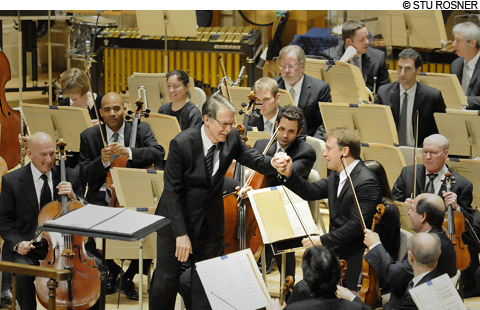
HAPPY “HANGOVER” John Harbison takes a bow with conductor Ludovic Morlot after the BSO’s performance of Harbison’s Symphony No. 4. |
In his second week with the BSO, Ludovic Morlot led another stunning program originally designed for James Levine. This one included the latest installment in the continuing cycle of symphonies by Boston's beloved John Harbison (the BSO premiere of No. 4, from 2003; the Fifth follows this coming week, and the world premiere of the Sixth concludes the series in January).The Fourth is complex in its mental and emotional states yet is consistently and immediately engaging. Its five movements encompass a lot of territory in all of half an hour. Except for the fourth movement, "Threnody," a powerful, almost heart-on-sleeve lament ("not about loss," Harbison writes, "but about the imminence and inevitability of loss," with some of the saddest music for violas I've ever heard), the other four movements, even the opening "Fanfare," veer back and forth between opposing attitudes, almost as if they're figuring out which direction to take.
Harbison says this symphony was written to get over his "hangover" from his biggest effort, The Great Gatsby, the jazz-age opera he wrote for the Met. The punchy, obsessive, and rather jazzy fanfare itself alternates with a much lighter, more insouciant dance for strings and delicate winds. The following Intermezzo has some gorgeous writing for marimba, vibes, and glockenspiel, some delicious solos for horn (with distant chimes), English horn, and violin, and ends, indecisively-on-purpose, with shimmering cymbals. An inconclusive dialogue for violins and brass appears in the syncopated Scherzo. After the Threnody, the Finale finally, slowly, takes off then carries you away. Right now, this black sheep is my favorite Harbison symphony, but that opinion may just be the aftermath of a refined and uninhibited performance that seemed completely on target.
The Second Suite from Ravel's "symphonie choréographique" Daphnis et Chloé is a piece the BSO could play in its sleep. But as with the previous week's Berlioz Roman Carnival Overture, Morlot ignited this familiar BSO showpiece with fresh fire. It was like listening to light waves: sparkling, impassioned, irresistible. This was spectacular high-definition sound — 3D! — helped immeasurably by Morlot's use of Levine's antiphonal seating plan for first and second violins (he's the only guest conductor to do so this season). Elizabeth Rowe rendered the famous flute solo (Pan's longing for Syrinx) in a pure, exquisitely spun-out tone that also captured the music's luscious sensuality.
Then Mahler's First Symphony: maybe the greatest first symphony ever written (there's Brahms, of course, but the Mahler is much more fun). This was a lean, prismatic, unmelodramatic reading combining delicate textural clarity, wit, and visceral power. Early in the first movement the sounds of nature coalesce into a sweet melody from Mahler's Songs of a Wayfarer, for which Morlot elicited playing of the most loving tenderness. He vividly, rhythmically, sharpened the second movement's contrast between a thumping peasant dance and Mahler's dream of an elegant, worldly salon, which interrupts it — until it reasserts itself (you can take the boy out of the country, but you can't take the country out of the boy).